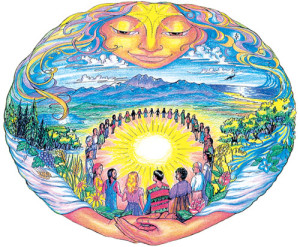 First: a new religious language. The religious metaphors of the Judeo-Christian tradition developed in a patriarchal society and show the limitations of that particular experience. The Father God metaphor, for example, while suggesting paternal care, also evokes absolute power, patriarchal authority, harsh punishment, and other related ideas which are now considered controversial. The NAM, by searching for inspiration in the many religious traditions of the world, especially in mysticism, opens up a new field of religious metaphors which may help us to more meaningfully re-imagine God for contemporary humanity.
First: a new religious language. The religious metaphors of the Judeo-Christian tradition developed in a patriarchal society and show the limitations of that particular experience. The Father God metaphor, for example, while suggesting paternal care, also evokes absolute power, patriarchal authority, harsh punishment, and other related ideas which are now considered controversial. The NAM, by searching for inspiration in the many religious traditions of the world, especially in mysticism, opens up a new field of religious metaphors which may help us to more meaningfully re-imagine God for contemporary humanity.
Second: a new understanding of spiritual life. Western Christianity … strongly emphasized its institutional character. Humanity’s relationship with God was regulated by the authoritative mediation of doctrines, laws, rituals and sacred ministers. To believe was to know and to obey. The NAM, on the other hand, searches for a direct experience of the divine, finding inspiration in, for instance, Zen Buddhism, which views authority as counter-productive. The answers to all the great questions of existence lie within, in the inner depths. To find them is the purpose of life.
Third: new spiritual practices. Many Christians often fail to find ways to put into practice the virtues of love, compassion, and peace. Eastern spiritual exercises (meditation techniques, Yogic disciplines, mantras and breathing practices, concentration and mindfulness methods) seem to offer them concrete means to arrive at a greater quality of life and consciousness.
Fourth: appreciation of all religions. We live in a global world which challenges us to re-evaluate the Christian exclusivism of the past. We are becoming more aware that different cultures and religious traditions contain their unique wisdom and spiritual genius. NA thinkers hold that all religions and their adherents are worthy of respect and appreciation.
Fifth: a lay spirituality. The catholic tradition reserved the higher form of spirituality for its professionals, priests and religious. To be lay was to be spiritually inferior, at best, a second class way towards holiness. In NA spirituality, no state of life is intrinsically holier than any other. Ordinary people are invited to spiritual growth within their daily lives.
Sixth: spiritual mentorship. The tradition of a spiritual teacher who gives personal spiritual guidance over an extended period has never fully developed within the Christian tradition. The NAM offers teachers to the many people searching for interiority and higher consciousness.